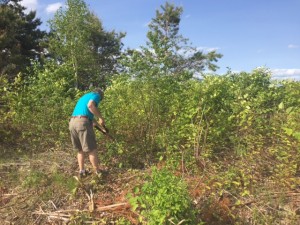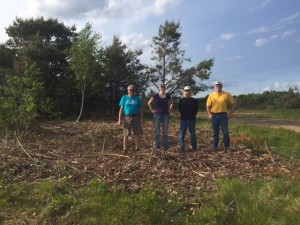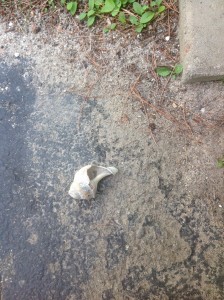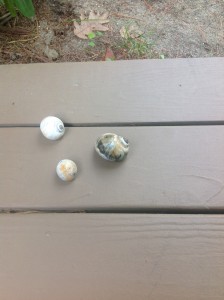Salmon, shad, and alewives were formerly abundant here, and taken in weirs by the Indians … until the dam and afterward the canal at Billerica, and the factories at Lowell, put an end to their migrations hitherward; though it is thought that a few more enterprising shad may still occasionally be seen in this part of the river…. Perchance, after a few thousands of years, if the fishes will be patient, and pass their summers elsewhere meanwhile, nature will have leveled the Billerica dam, and the Lowell factories, and the Grass-ground River run clear again, to be explored by new migratory shoals. – A Week on the Concord and Merrimack Rivers
Yes, it often seems that hope is measured in “thousands of years,” but every so often it shows up as more immediate; sometimes there’s even a human helping hand.
May 25th: It’s the day after the Damariscotta Mills Fish Ladder Restoration Festival, but when we arrive a little before noon, the gravel lot is mostly full, even as the festival signage is down. For the first time this year, the sun is summer hot. We cross over a small bridge, and I look down into the clear water flowing toward the salt pond downstream. We are at what’s called the head of the tide – fresh water upstream to our left, salt to the right. We’re here to see the anadromous alewives as they complete their spawning swim from the sea to Damariscotta Lake, which is exactly 42 feet above this meeting of waters. Up those feet they must go…without feet, of course.
The tents for the festival are still pitched, but only a stain from a dwindling pile of melting ice suggests that yesterday this flat spot by the stream was full of noisy human celebration, including the chance to eat the smoked brethren of those swimming by.
We idle forward and turn left, upstream by some buildings that once made use of the river running by; the falls rise ahead, and just across the narrow river it’s impossible to miss a squall of gulls. They are sleek and loud; for them the festival happens every day of the spring run. Also across the river at the fall’s base lies a stretched curtain of orange plastic meant to discourage ambitious fish, who would go right at the impossible falls. Instead they are meant to aim right, where a small, rounded pool empties into the river. Above that pool, another, and another, and on…up; the ladder rises. Now, in these pools six-or-so feet across, we can see the concentrated fish in dark tens as they circle, gathering, we suppose, strength and the fishy equivalent of resolve for the next climb to the next pool a foot above.
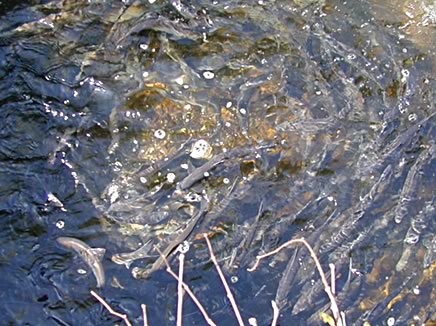
Swirl of alewives in one of the pools. Photo: Russ Williams
A narrow path runs up beside the pools, and we climb its shallow slope. At pool ten, we lean on the railing and watch the swimming swirl of fish; then, we begin to watch the thick muscle of descending water from pool eleven; we watch it closely. Do alewife jump upstream like salmon, leaping then lagging back, then repeating until they gain the next bit of slackened water? No fish breaks the surface, but there, there goes a black streak close against the dark brown stone underwater; up goes a fish, and another, another still…ten in a minute. So they rise, one by one, pool by pool.
Later, at the top of the ladder, we lean again on the railing and watch the portal where the placid lake water begins to gather speed before disappearing down stream into the ladder. To the left a swirl of 30 fish spins in the currentless water- What now? their swimming seems to ask; What now? Then, apparently at some signal, they shoot away up lake as a pack; the water is empty; its dark olive bottom vacant…for a bit. Nearby, we can make out the outline of a long-sunken skiff.
A fish appears. It seems just that – appearance from nowhere. Another materializes. And now, if we watch closely, we can see each quick dark streak as each alewife reaches a summer of procreation and slow swimming. It is the promise lake.

The Ladder
Back downstream, we pause again at the ladder’s outset, where the aspirants gather in the quick water, amid the claque of gulls. Up close, the gulls look huge, their wing span equal to the spread arms of an adult human. A gull lifts up and drops into the water, beak down; he lifts his head and flaps up into the air again. From his beak a full fish protrudes, its tail flipping still. Other gulls zero in on their successful relation; he tips back his head and swallows the eight-inch fish whole, chokes it down in a hurry. His neck swells like a stuffed sock, and his relatives veer away, as if to say, “Aw, Chuck bolted another down whole; Chuck’s no fun.” They settle again to watching: for fish near the surface, and each other. Within a minute four more gulls catch fish and, just like Chuck, they bolt them whole, each taking the fish down head first.
In 2013, an estimated 900,000 alewives made it to Damariscotta Lake, even after people and gulls removed their share. Who knows what this year’s tally will be? During this 30 minutes, we’ve seen a few hundred of that tally climb an inspired and inspiring ladder, living on into one of the earth’s best stories of return.
As we turn to go, hundreds more alewives press on upstream. The water roars; the gulls squall, dive and squabble; urgency reigns. So too does life.
Here’s the web address for the folks who have restored the fish ladder. The site is rich with information and its photo gallery is superb.
Link:https://damariscottamills.org/

